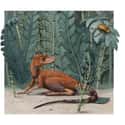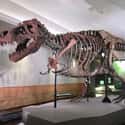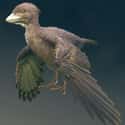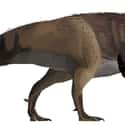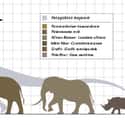-
(#1) Dinosaurs Might Have Evolved From A 4-Inch-Tall Reptile
In an article published in the journal Proceedings of the National Academy of Sciences on July 6, 2020, researchers described a newly discovered ancestor to giant dinosaurs and flying pterosaurs dug up in Madagascar. The Kongonaphon kely is approximately 4 inches tall and 237 million years old.
The lead author on the study, Christian Kammerer, mused the Kongonaphon kely "would probably make a great pet." Its name means "tiny bug slayer," a reference to the idea that it would jump around on its hind legs catching bugs all day.
Examining a section of the thigh bone allowed researchers to conclude the fossil is that of an adult.
-
(#2) Paleontologists Discovered A Burial Site That Suggests Some Dinosaurs Were Cannibals
Paleontologist Stephanie Drumheller-Horton, from the University of Tennessee-Knoxville, and her colleagues found hundreds of fossils at the Mygatt-Moore Quarry bonebed off the Colorado-Utah border. Of the 2,000 fossils found at the site, 28% showed punctures, scratches, and bite marks from other carnivorous dinosaurs, suggesting some species fed on their own kind. A survey of the bones published in the PLOS ONE academic journal suggests "the first evidence of cannibalism in Allosaurus" because of the "relative abundances of the carnivores, partnered with the size-estimates based on the striated bite marks, [and] the feeding trace assemblage." More likely these dinosaurs were scavengers, however, as opposed to actively hunting their own kind.
Paleontologist Joseph Peterson, who was not involved in the study, told Smithsonian magazine the dinosaurs at the Mygatt-Moore Quarry site likely acted different because of weather conditions. During the dry season, meat like fish and crocodiles are rare, so carnivores might have picked at dinosaur carcasses searching for meat before the wet season buried the remaining bones and preserved them as fossils.
-

(#3) The Reaper Of Death Is The First New Tyrannosaur Discovered In Canada In 50 Years
Introducing the first new species of tyrannosaur discovered in Canada in 50 years. Meet Thanatotheristes degrootorum, the ‘reaper of death’! Read all about it on our blog: https://t.co/hIQZkxdACk #Thanatotheristes #ReaperOfDeath #RTMPResearch pic.twitter.com/WYNmsMuUFY
— Royal Tyrrell Museum of Palaeontology (@RoyalTyrrell) February 10, 2020Researchers with the University of Calgary and the Royal Tyrrell Museum revealed what they claim to be the first new tyrannosaur species discovered in Canada in 50 years, called the Thanatotheristes degrootorum - which combines the Greek translation for "reaper of death" with the name of the couple who found the fossils, the DeGroots. Jared Voris, a PhD student, found the skull fragments at the Royal Tyrrell Museum, and he concluded they did not match any known species of tyrannosaur, in part because of unique "vertical ridges along the upper jaw line."
The fragments Voris discovered were found near the Bow River by in 2010. Voris' thesis advisor, Darla Zelenitsky, said the new species predates the T. rex by 12 million years, and is therefore the "oldest known tyrannosaur discovered in Canada."
This Thanatotheristes appears to be its own distinct species, rather than an ancestor to the T. rex, and Voris speculates it could have been "8 meters long with an 80-centimeter skull."
-
(#4) The T. Rex Had A Major Growth Spurt As A Teenager
A study released in Science Advances magazine January 1, 2020, alleges the T. rex grew into its full size during adolescence, rendering the existence of the Nanotyrannus, or pygmy tyrannosaur, invalid. Scientists have previously proposed a smaller T. rex lived alongside the giant predators after examining two tyrannosaur skeletons from the Cretaceous period with a similar body structure. The new research, which used osteohistology (the study of bones) to analyze the same samples, studied their growth curves to identify their age, revealing they were "immature individuals 13 to 15 years of age, exhibiting growth rates similar to extant birds and mammals, and that annual growth was dependent on resource abundance."
Paleontologist Steve Brusatte, who reviewed the study, said most scientists are unfamiliar with the growth rates of the T. rex aside from the fact that they "had to grow fast to go from... hatching" out of an egg to approximately 19,000 pounds. Because the two fossils examined by researchers previously thought to be an entirely new species of pygmy dinosaurs are actually adolescent in age, it is likely the T. rex began to grow more rapidly during its teenage years depending on the available food sources.
-
(#5) A Well-Preserved Fossil Provides New Information About The Evolution Between Dinosaurs And Modern Birds
Paleontologist Takuya Imai and colleagues discovered the well-preserved fossil of an Early Cretaceous bird in Japan in 2013. The skeleton, called the Fukuipteryx prima, or F. prima, is the first modern bird recorded outside northeastern China, according to a study published in Nature in November 2019. The study further suggests finding a modern bird skeleton outside China "increases our understanding about the complex morphological evolution in early birds with the presence of particularly primitive features in young individuals," given the animal's assumed age of about 1 year.
Imai told Smithsonian magazine researchers "were not expecting to find such good material from a fossil bird." Similar fossils discovered in China were often squished and incomplete, whereas this one was three-dimensionally preserved. And though the F. prima skeleton is assumed to be nearly 120 million years old, it looks similar to birds that evolved 30 million years earlier in the Jurassic period.
One of the most important features of the F. prima fossil might be its tailbone, also seen seen in birds today and thought to be a marker of birds' evolution from dinosaurs.
-
(#6) Dinosaurs Might Have Been Warm-Blooded
For much of paleontological history, many have associated dinosaurs with reptiles - thus, concluding dinos were cold-blooded. However, the evolutionary connections between dinosaurs and birds, along with the revelation most dinosaurs likely had feathers, has led scientists to reevaluate this conclusion.
Since dinosaurs didn't use feathers for flight, it's more likely they were for insulation, which would suggest warm blood. It remains unclear whether all or only some dinosaurs were warm-blooded, but it is possible the trait was universal. In 2020, palentologists published a study that confirmed Ornithischia, Sauropodomorpha, and Theropoda were warm-blooded dinosaurs.
The study, published in Science Advances, tested the temperature of fossilized eggshells to measure the body temperature of certain dinosaurs.
-
(#7) Scientists Discovered An Unusually Small Dinosaur Related To The T. Rex
The Suskityrannus hazelae lived about 92 million years ago, is approximately 3 feet tall, and has similar skeletal features to the Tyrannosaurus rex. Just over 20 years ago, paleontologists discovered a couple of partial skeletons in New Mexico that promised insight into a new species. The fossils did not provide enough information to really understand who the creature was, however, according to Virginia Tech scientist Sterling Nesbitt who is responsible for unearthing one of the remains.
There have been developments in recent years that allowed paleontologists to build the Tyrannosaurus family tree, and given the S. hazelae fossils feature signature structural similarities to the T. rex, scientists have deduced the two species are related.
Robert Denton, a geologist at Terracon in Ashburn, Virginia, says the S. hazelae have strong feet and a strong jaw, which allows it to optimally crush its prey, just like the T. rex. Given the size of the S. hazelae, scientists believe the T. rex must have developed their predatory features while they were still quite small.
-
(#8) The Archosaur Lizard King Ruled Antarctica Long Before The T. Rex
Millions of years before the T. Rex took on the title of the "lizard king," an iguana-sized archosaur reigned over Antarctica. Scientists discovered a 250 million-year-old fossil that allowed them to identify that the reptile was likely four to five feet long and ran along the ground. They call it the Antarctanax shackletoni which means "Antarctica King."
Brandon Peecook, head researcher at the Field Museum of Natural History in Chicago, told Live Science that the creature "doesn't have any adaptations in its feet that would make [him] think it lived in the trees or that it's a burrower."
The discovery of the Antarctanax shackletoni allows paleontologists more insight into the evolution and ultimate extinction of the dinosaurs because it suggests "all these other crazy lineages must have existed."
-

(#9) The Biggest Animal In The World Was Actually The Ledumahadi Mafube - A 26,000-Pound Dinosaur Twice The Size Of An African Elephant
In September of 2018, a new dinosaur claimed the top spot as largest animal on Earth. Researchers in South Africa revealed a new, giant relative of the brontosaurus estimated to have been nearly twice the size of the massive African elephant, based on its restored fossil. Named “Ledumahadi mafube” - or “a giant thunderclap at dawn” in the local language of Sesotho - researchers now believe this dinosaur was one of the largest animals on Earth during the early days of the planet’s existence, about 200 millions years ago. These 26,000-pound creatures were most likely related to the giant dinosaurs inhabiting what is modern-day Argentina, when Pangaea made overland transport more accessible.
Reportedly, the Ledumahadi is closely related to sauropod dinosaurs - similar to the brontosaurus. But unlike the famous four-legged, plant-eating bronty, the Ledumahadi is believed to have been what researchers call a “transitional” dinosaur, or what CNN described as “an evolutionary experiment… during the early Jurassic period [in which] the forelimbs of this dinosaur are more ‘crouched,’ while being very thick to support its giant body.”This presumably means the dinosaur may actually have evolved from two-legged ancestors, but scientists posit the way in which it evolved to four legs helped its digestive system handle a more vegetarian-based diet.
-
(#10) The Tyrannosaurus Rex Definitely Wasn’t Fast Enough To Chase A Jeep
One of the most famous scenes in Jurassic Park features a Tyrannosaurus rex chasing down a group of the film's protagonists as they speed away in a Jeep. However, despite the impressive size of its legs, the T. rex was probably not able to run much at all. Scientists previously estimated the T. rex could travel at speeds as high as 33 mph, but a 2017 study using complex computer models estimated the creature could only travel a maximum of 12 mph.
-
(#11) Most Dinosaurs Had Feathers
Books and educational materials traditionally depicted dinosaurs as giant lizards. However, this is beginning to change as their evolutionary connection to birds is becoming increasingly apparent. The idea of a dino with plumage is difficult to imagine, but the majority of paleontologists now agree most - if not all - dinosaurs had feathers.
The discovery didn't happen all at once, but in stages, as researchers discovered more feathered specimens, and the truth became impossible to ignore. Since feathers don't usually preserve well, it took years before scientists discovered enough fossils to support the hypothesis. At first, only flesh-eating dinosaurs purportedly had feathers, but the discovery of a well-preserved, feathered herbivore species in 2014 compelled paleontologists to consider perhaps all dinosaurs were downy.
-
(#12) The Brontosaurus Was Real After All
The Brontosaurus is one of the most recognizable dinosaurs, thanks to frequent mentions on the TV show The Flintstones. For a long time, however, many paleontologists didn't believe the species existed. The Brontosaurus came about when a paleontologist misidentified an Apatosaurus skeleton during the overly competitive fossil-hunting competition termed the "Bone Wars."
In 2015, a research team challenged this belief when they found "significant differences" between typical Apatosauruses and the original Brontosaurus specimen. The Brontosaurus appears poised to finally re-enter the history books.
-
(#13) The Triceratops Kind Of Didn’t Exist
In 2010, a study revealed the Triceratops species didn't exist, and the internet flew into a panic at the disappearance of one of the coolest-looking dinosaurs. The truth turned out slightly more complex. Researchers found the previously uncovered Triceratops specimens were younger Torasauruses, rather than their own distinct species.
However, as the original research paper mentioned, researchers coined the name Triceratops a few years before Torosaurus, so the official name of the species remains the former.
-
(#14) Dinosaurs Were Surprisingly Good Parents
It is challenging for paleontologists to determine the behavior pattern of dinosaurs due to the sheer time span between the present and when dinosaurs became extinct. While previous schools of thought likened dinosaur parenting to that of modern lizards (most of which lay their eggs, then abandon them), more recent discoveries have hinted several species watched over their eggs and sometimes reared their young hatchlings.
Researchers consider one species in particular, the North American Troodon, the “poster genus for child-rearing theropods” because of their extreme efforts to protect their eggs and younglings from harm.
-
(#15) The Stegosaurus Did Not Have A Second Brain In Its Pelvis
Many widely thought the Stegosaurus had two brains - a tiny one in its head and another supplementary one in its pelvic cavity. The idea the Stegosaurus had a second brain, however, was simply a theory. Modern theories suggest the cavity might have contained a glycogen body, which stores energy. Modern birds have these structures, so it's likely the Stegosaurus had one as well.
The function of the Stegosaurus's "spikes" remains a mystery; researchers hypothesize they were perhaps for mating purposes.
-
(#16) Pachycephalosauria Did Not Butt Heads With One Another
The Pachycephalosaurus isn't a household name, but most can imagine the dome-headed beasts ramming their skulls into one another. Unfortunately for fans of dino-on-dino combat, modern paleontologists don't believe the Pachycephalosaurus skull could have survived more than a single high-speed collision.
By closely studying the microstructure of the Pachycephalosaurus's skull tissue, researchers determined their massive noggins simply couldn't withstand headbutting contests; their dome-shaped skulls were merely for show.
-
(#17) The Spinosaurus Was An Aquatic Dino
The Spinosaurus had a starring role in Jurassic Park III, thanks to its enormous size and vicious claws. Though the film depicted the Spinosaurus battling a Tyrannosaurus rex on land, a 2014 discovery in North Africa confirmed the species was primarily an aquatic dinosaur.
Accordingly, Spinosaurs were similar to crocodiles in many ways, including their snout shape and bone structure, which made them well-adapted to hunting in the water. The dinosaur's aquatic connection was further cemented by the discovery of a nearly complete tail fossil, which resembles a paddle.
The anatomy of this tail suggests that, rather than catching fish at the edge of bodies of water, the Spinosaurus was an active swimmer. According to a study published in the journal Nature:
Contrary to recent suggestions that Spinosaurus was confined to wading and the apprehension of prey from around the edges of bodies of water, the morphology and function of its tail - along with its other adaptations for life in water - point to Spinosaurus having been an active and highly specialized aquatic predator that pursued and caught its prey in the water column.
-
(#18) The Traits Defining A 'True' Dinosaur Have Become Extremely Ambiguous
As paleontologists have dug up more prehistoric remains and added to the fossil record, the number of known dinosaur species has skyrocketed. This increase in awareness has led to a decrease in the number of traits distinguishing dinosaurs from other animals.
Having found more traits previously thought of as unique to dinosaurs in non-dinosaurs, paleontologists narrowed down the list of what defines a legitimate dino. According to paleontologist Randall Irmis, the only distinguishing feature of a dinosaur is "having a complete hole in the hip socket.” Every other feature appears in non-dinosaurs. The hips, however, don't lie.
-
(#19) The Entire Dinosaur Evolutionary Tree Was Way Off
Because we are constantly discovering new information about dinosaurs, the basic evolutionary tree of these creatures has changed dramatically. Many accepted this tree for over 100 years before a 2017 study of dozens of species by paleontologist Matthew Baron suggested Theropods belong in a group with Ornithischians, under the heading of Ornithoscelidans.
In other words, the T. rex had more in common with bird-lipped dinosaurs, like the Triceratops, than with long-necked creatures, like the Apatosaurus.
-
(#20) Instead Of Roaring, Dinosaurs Probably Honked Like Ducks And Geese
The image of the Tyrannosaurus rex letting out a mighty, bellowing roar is one of the most memorable scenes from the Jurassic Park series - but it's also something a real T. rex wouldn't do. Dinosaurs would have had a syrinx like birds, not a larynx like mammals, and thus would have been incapable of producing a roar.
A 2016 study of a preserved voice box from a duck-like bird ancestor provided paleontologists with a good idea of what sounds dinosaurs could have produced, which include clicks, hisses, and honks similar to that of modern ducks and geese.
-
(#21) Paleontologists Have Little Idea What Dinosaurs Looked Like Aside From Their Skeletal Structure
Most people have a clear mental image of what they think dinosaurs looked like, but these representations have a basis in scientific speculation and popular culture. Two paleoartists C.M. Kosemen and John Conway published a book titled All Yesterdays; they presented alternative interpretations of the fossil record to show dinosaurs could have appeared remarkably different than our modern interpretations.
To make their point, the artists also depicted a few modern animals drawn in the skin-tight, leathery style of most dinosaur representations. In the aforementioned style of illustration, pictured above is a baboon.
-
(#22) Scientists Discovered The Patagotitan, The Largest Animal Ever To Walk On Land
Scientists have discovered several new dinosaurs species in recent years. Some consider our current era the “golden age” of dinosaur discovery, especially since unique creatures are popping up frequently. Most notable is the Nanuqsaurus, an Arctic tyrannosaur. Scientists are finally tapping the fossil resources of some continents like Australia, revealing all sorts of new species.
These discoveries aren't insignificant, either - in 2013, they discovered the Patagotitan, which is the largest animal to ever walk on land.
-
(#23) A Massive Increase In The Fossil Record Means That Dino-Science Will Remain In Continual Flux
Paleontologists are aware their understanding of dinosaurs may completely change over the next few decades. The fossil record is growing at a rapid rate. As paleontologist Jonathan P. Tennant explains, "There are still huge gaps in our knowledge of the fossil record, and areas in space and geological time where the rapid pace of discovery is changing much of what we thought we knew about dinosaurs."
This “golden age” of discovery has ensured there are already enough fossils available to inspire another few decades of dino revelations. Moreover, there are still multitudes of bones awaiting discovery.
New Random Displays Display All By Ranking
About This Tool
The earth is about 4.6 billion years old. Dinosaurs lived on this mysterious and huge blue planet about 150 million years ago, and humans appeared about 6 million years ago. Unfortunately, dinosaurs were extinct during the Cretaceous period. For centuries, biologists have different opinions on the reasons for the extinction of dinosaurs, the most convincing theory is that an asteroid impact caused the disappearance of dinosaurs.
Over the years, dinosaur fossils of different periods and types have been discovered, which provide the most powerful evidence for historical research and biological evolution research, and humans can continue to explore the mysteries of dinosaurs. You could know 23 crazy facts about dinosaurs in this random tool.
Our data comes from Ranker, If you want to participate in the ranking of items displayed on this page, please click here.










